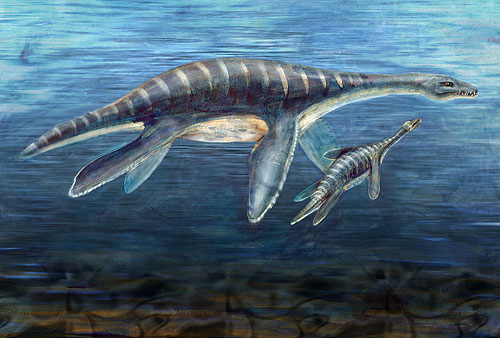From July 21st to the 28th, the team at New Creation set off for a couple of creation science conferences, held back to back. The purpose of these events is for creation scientists and other researchers to present the findings of their work to their peers. We summarized our experience at the conferences a few weeks ago. But today, we wanted to prepare a short summary of some of the talks given over the course of conference week for those who were unable to attend.
Origins Conference Summaries
The Origins conference is an annual gathering of scientists and theologians from the Creation Biology Society, the Creation Geology Society, and the Creation Theology Society. This year, the conference was held in St. Louis, Missouri from July 21st to July 23rd. The proceedings began with a series of talks from the Creation Biology Society, followed by an interdisciplinary session hosted by the Creation Theology Society, and ended with some presentations from the Creation Geology Society.
Preliminary Analysis of Plesiosaur Baraminology
Research by S. Schupbach and M.A. McLain
Plesiosaurs are an extinct group of marine reptiles that once dominated the world’s oceans. They came in a wide variety of forms. On one end of the spectrum were the long-necked varieties with tiny heads, like Elasmosaurus and Plesiosaurus. They resemble the Loch Ness Monster. On the other end of the spectrum were short-necked plesiosaurs with giant, toothy heads. This group includes animals like Pliosaurus and Liopleurodon. But despite all of this diversity, all were united in how they plowed through the water with four powerful flippers.
It was once very easy to classify plesiosaurs as belonging to one group or the other. Nowadays, scientists recognize this as more difficult because there are some long-necked plesiosaurs that are more skeletally similar to the short-necked plesiosaurs than they are to other long-necks. And vice versa. Virtually no creationist research has been performed on plesiosaurs until now. In this study, Schupbach and paleontologist Matt McLain wanted to determine if all plesiosaurs belong to a single created kind, or if this group is made up of multiple created kinds. To do this, these researchers used a technical computer program called BARCLAY that compared the similarities and dissimilarities of various plesiosaur species. Also included in the analysis were non-plesiosaur marine reptiles, like the nothosaurs.
It was found that there were very clear distinctions between non-plesiosaur marine reptiles and plesiosaurs themselves. Moreover, it was found that the families Pliosauridae and Rhomaleosauridae are both distinct unto themselves from other plesiosaurs. This led Schupbach and McLain to hypothesize that these plesiosaur families are each their own created kind. While more research is needed on the group of plesiosaurs as a whole, it appears that this batch of animals is made up of several different created kinds.
A Preliminary Baraminological and Biostratigraphic Analysis of Giraffoidea
Research by C. Ryan and P. Brummel
Two of our writers, Christian and Peter, presented a baraminological study of giraffes. Their interest in the topic was sparked by the Ark Encounter attraction. The attraction chose to represent the ancestors of modern giraffes as a short-necked fossil form called Shansitherium. However, little baraminological work had been done to demonstrate the relationship between modern giraffes and the many fossil forms.
Christian and Peter performed statistical analyses on two datasets. One of the datasets was a more general phylogenetic analysis, including many ruminant taxa. The other focused on the family Giraffidae. Their analyses supported the conclusion that all Giraffoids belong to the same kind. That means that modern long-necked giraffes are related to okapis or forest giraffes. They likely shared a common, short-necked ancestor.
A stratigraphic analysis of the distribution of giraffoids over time was also performed. Using data from the Paleobiology Database, they created a series of maps showing the spread of giraffes across the world. The order of appearance of taxa in the fossil record appeared to correlate with their phylogenetic positions and the placement of the taxa when plotted in multi dimensional space based on morphological characters.
A Survey of the Use of Min in the Dead Sea Scrolls
Research by J. Lyon
For creation biology, specifically the subdiscipline of baraminology, the meaning of the Hebrew word “min” is a major question. Jeremy Lyon presented a survey of the use of this word in the Dead Sea Scrolls. While most of our knowledge of ancient Hebrew comes from the Old Testament, the Dead Sea Scrolls also contain non-Biblical texts that can help broaden our understanding of certain terms. The results of this survey show the Hebrew word “min” is used to delineate broad categories such as living things from non-living or physical things from non-physical, as well as for hierarchical categorization of smaller sets within larger sets. While a precise definition is not forthcoming, the use of this word in non-Biblical texts illustrates a broader semantic range than exhibited in the Old Testament. This may reflect a more narrow range of use for the word “min” during the time of Moses, or perhaps may result from the Biblical authors intentionally using the word for very specific purposes.
Is the Paleolithic a True Historical Period? Developing a Database of Archaeological Sites from the Ancient Near East
Research by T.C. Wood and P. Brummel
Dr. Todd Wood presented a sneak peak of his research into the order of the archaeological record. According to the Bible, significant cultural inventions were made just seven generations after Adam. Tubal-cain forged bronze and iron tools. Jubal was “the father of all those who play the lyre and pipe.” Unfortunately, we do not have tools or fossils of these pre-flood people. The earliest known artifacts come from people who lived after the dispersion from Babel. The artifacts seem to appear in a particular order.
Evolutionists interpret this order as representing the evolution of human intelligence. They claim early hominids were not very smart. Their “tools” were little more than chipped rocks. Primitive humans began to make hand axes and other stone tools. But, these people lived for hundreds of thousands of years without further innovation. Even after people with modern intelligence evolved, they continued to use stone. But, their tools were more finely made. Around 4,500 B.C. people began to refine and utilize copper. This led to the discovery of bronze, (a copper alloy), and eventually iron.
Many creationists are reluctant to accept the supposed order of the archaeological record. The ages of the tools are determined using radiometric dating. However, studies have shown that dating methods do not always align. Using different methods on the same sample can get you different results. So, it is unclear if ages obtained from different methods are even relatively correct.
The post-Flood patriarchs lived for hundreds of years. The lifespan of a single individual might have spanned the entire stone age as well as subsequent “ages”. So, is the order of the archaeological record real? Dr. Wood hopes to answer this question by examining the record without reference to dating methods. By relying on stratigraphy, the order of rock layers, we can confidently determine the relative ages of tools. In a vertical sequence of rock layers, the bottom layer is oldest.
Dr. Wood has been compiling a database of middle eastern archaeological sites. He has drawn from various online sources and lists in the scientific literature. So far, he has identified 547 sites from 17 countries within the study area. Going forward, he will analyze the order of tool succession at each individual site. Hopefully, this work will identify actual trends in the archaeological record. These trends may help us understand how people regained culture following Babel.
Tracking the Trends: Analysis of Over 100 Radiocarbon Measurements in ‘Ancient’ Fossil Material
Research by E. Issacs
Studying the decay of the radioactive carbon-14, radiocarbon dating has been claimed by many creation scientists as a strong argument against an old earth. With a short half-life of 5,730 years, the original Carbon-14 that was introduced into, say, a bone while an animal was alive should no longer be detectable after just tens of thousands of years after the animal died (we can say 100,000 years max though most labs would consider even that value optimistic). Even if the whole Earth was a ball of carbon-14, the last remnants of that carbon-14 would no longer be detectable after just a million years! Because of that, original carbon-14 should not be present in biologic materials if they are millions of years old.
Contamination could conflate the value of carbon-14 in a sample, but the discovery of carbon-14 in some diamonds, which should be virtually immune to contamination especially when handled by some of the most advanced labs in the world, show that it is very likely that this carbon-14 is original to the sample even though the diamonds are often thought to be billions of years old. That carbon-14 just simply shouldn’t be there! Of course, this raises the question of why carbon-14 is found in things like dinosaur bones when, in old-earth geology, they are supposed to be hundreds of times too old to have original carbon-14. Many creation scientists then look at this as evidence that those dinosaur bones are simply not that old after all, but instead fit into the timeline of a creation and subsequent global Flood just thousands of years ago. Still, no creation scientist has yet fully answered the question: what does that imply for our Flood model? Does carbon-14 tell us anything unique about the global flood?
When faced with challenges like these, it’s essential to use model-building to explore how new data might fit within our existing frameworks. For instance, finding a carbon-14 date in the tens of thousands of years for a dinosaur bone doesn’t necessarily align with a young earth timeline if taken as a literal age. To that end, Isaacs and Clarey gathered over 100 radiocarbon dates from ‘ancient’ fossil material, the largest of such datasets, to see what sort of trends they could find. Through their statistical analyses, they found that radiocarbon dates formed several populations that could be statistically distinguished from each other. In fact, radiocarbon dates from fossil wood, coal, and fossil bone all date in their own distinct populations that can be distinguished from one another. This does not seem to line up with what we would expect if these dates were only from contamination. Instead, it indicates that whatever factors did contribute to these differing apparent ages were affected by the type of material involved. This means that if radiocarbon dating was to be calibrated, we could not do so using a single calibration curve, but one that took this feature into account.
One possible explanation for these distinct populations is their ability to integrate Uranium. The decay of uranium can, much like solar radiation, generate carbon-14 and, interestingly enough, materials that have higher uranium levels also tend to give younger apparent radiocarbon ages. If radioactive decay was higher during the Flood, the decay of uranium could be high enough to generate these radiocarbon signatures in a trackable way. In any case, far more research is needed, but these results suggest that integrating radiocarbon data into the Flood model will be a challenging but fruitful endeavor.
A Reassessment of the Timing of Terrestrial Tetrapod Extinction and the Period of Worldwide Submergence During the Flood
Research by C. Ryan
The Period of Worldwide Submergence (PWS) occurred during the Flood when all the high pre-Flood mountains were submerged (Genesis 7:19-20). Most young-earth creationists think this happened between Day 40 and Day 150 of the Flood year, and coincides with the death of the last air-breathing land animals not aboard the Ark.
One of the difficulties with this model is the presence of trace fossils left behind by air-breathing land animals in late-Flood sedimentary deposits. These include footprints, nests, eggs, and droppings. They are traces a live animal left behind, rather than the body of the animal itself. Thus, they must have been formed in place by living animals. In order to solve this problem, Ryan proposed that Day 150 only marks the end of the Flood’s prevailing phase, and not the extinction of the last air-breathing land animals. Instead, he argues that they may have died later in the Flood, as floodwaters began to recede but before Noah, his family, and the animals disembarked.
While this proposal may seem to go against a natural reading of the Flood narrative, Ryan pointed out that global Flood-affirming theologians and Bible scholars have been discussing the possibility that the Flood narrative is not strictly sequential for quite some time. While still generally chronological, certain elements of the Flood narrative may be arranged for thematic purposes, in accordance with recent Comparative Semitics studies. This view allows for the survival of some air-breathing land animals through PWS, perhaps by swimming or floating on vegetation mats. They could then produce trace fossils on newly exposed land surfaces as the floodwaters receded. Ryan encourages additional study to determine the validity of this model in alignment with the biblical text, as well as the plausibility of land animal survival through PWS.
Creation Research Society Conference Summaries
The Creation Research Society (CRS) Conference, hosted by the Creation Research Society, provides a forum for its members to present their latest research to their colleagues. Some of the presentations were on well-developed and tested ideas and results. Others were new and tentative ideas (speculations perhaps) that may eventually mature and develop into fully established research or never fully sprout. The conference provides speakers with an opportunity for a “test drive” of their research as they interact and exchange ideas. This year, the CRS Conference was held from July 25th to July 28th in Williamstown, Kentucky at the Ark Encounter, a theme park featuring a museum built to the scale of Noah’s Ark.
Bipolar Flows and Angular Momentum Transfer
Research by B. Hill
Creationists have often used the problem of angular momentum to argue against conventional models of star formation. According to theory, stars form from gas clouds, which increase in density and temperature as they contract until thermonuclear fusion ignites inside them. One problem with this model is that, as the gas cloud contracts, the conservation of angular momentum dictates that the nascent star will gain rotational speed, spinning faster and faster until it tears itself apart. While this is a valid issue in the conventional model, creationists often fail to recognize that this has been acknowledged in evolutionary literature for decades.
Dr. Bob Hill presented on this problem and updated us on recent research in this area. Herbig-Haro objects are bipolar jets of material ejected by stars in the early stages of their development. Astronomers have used Doppler measurements to determine that these jets are rotating. This rotation transfers angular momentum away from these ‘protostars,’ and calculations show that this process can effectively transfer enough angular momentum within the timeframe of that particular stage of stellar development. This provides a plausible solution to one aspect of the angular momentum problem in stellar evolution. It is important for creationists to stay informed about the work being done in evolutionary astronomy so that we don’t mischaracterize opposing views.
The Role of Natural Law in Creation Week, and Implications for Astronomy
Research by H. Klein
I (Klein) presented some thoughts on the relationship of the laws of physics and the events of Creation Week, specifically as it relates to creation astronomy. When God created the universe, to what extent were the laws of physics involved? There are a variety of perspectives on this issue. On one hand, there is the “mature creation” approach with everything created instantly, and no process of any sort involved. On the other hand, some creationists invoke a large amount of scientific processes during creation week. In my presentation, I suggested that the laws of physics were created in tandem with creative events, and thus were involved to some extent in the processes by which God created the universe.
One example of this is found on Day 4, when God created the astronomical realm. He states the twofold purpose of the stars: to create a reliable calendar (“for signs and seasons, days and years”), and to shine light on the earth. In this statement, we can see the ordination of the laws of motion that govern planetary and stellar orbits, as well as the establishment of the laws that govern electromagnetic radiation. This perspective allows for interpreting evidence of process in astronomy as possibly reflecting the events occurring during Creation Week.
Terra3D Models Provide Insights into Catastrophic Plate Tectonics and Western North American Tectonics
Research by S. Petersen and J. Baumgardner
Despite over a century of research, several geographic features of western North America pose a challenge for old-earth models to explain. These include the Great Plains region and the Western Interior Seaway that once existed along its extent, the Colorado Plateau, Grand Canyon, and the Rocky Mountains. The difficulty comes not in explaining any one of these features in isolation, but explaining all of these features, as their causes are often in direct conflict with each other.
While the Grand Canyon has received much attention by young-earth geologists, these other features provide them with an opportunity to develop a cohesive model. Petersen and Baumgardner use the TERRA, a finite element code Baumgardner designed himself to help scientists model plate tectonics. Applied to the North American west, these scientists have begun to model the effects of catastrophic plate tectonics on this region. The model discovered that the action of the North American continent oversliding another tectonic plate, the Farallon Plate, caused the mid-portion of the continent to downwarp, forming a basin and allowing the Western Interior Seaway to form. This led to thickening of western North America, allowing the Rocky Mountains and Colorado Plateau to rise up as a result.
Most Maniraptor Anatomy Shows Avian Form & Function
Research by G. Haynes and J. Leineweber
Since the 1990’s, significant fossil evidence has emerged showing that some types of dinosaurs had feathers. Despite this, some creationists have been skeptical about claims of “feathered dinosaurs.” This is because they think the acceptance of feathered dinosaurs relies on an evolutionary worldview that connects reptiles and birds. Creationists who do not accept feathered dinosaurs tend to sort these animals into one of two groups: 1) true birds that have been misidentified as dinosaurs, and 2) true dinosaurs with fossilized filaments misidentified as feathers.
This research by paleontologist Gabriella Haynes and coauthor Joel Leineweber focuses on the former group. They looked at several families of dinosaurs and identified features they considered to be more bird-like. These include a halfmoon-shaped bone in the wrist called a semilunate carpal and a fused series of bones on the tail called a pygostyle.
They claim that these features are often ignored by advocates of feathered dinosaurs, making them less bird-like than they truly are. As such, Haynes and Leineweber argue that feathered dinosaurs with these and other features are not truly dinosaurs at all. These include oviraptorids, dromaeosaurs (raptors), troodontids, scansoriopterygids, and alvarezsaurids. They think they are more appropriately classified as birds, and that it is not reasonable to accept feathered dinosaurs without adopting an evolutionary worldview.
Machine Learning Tools for Baraminology
Research by M. Cserhati and D. Cavanaugh
Matthew Cserhati and David Cavanaugh debuted a new website for statistical baraminology at CRS. Prior programs such as BARCLAY have used clustering algorithms to identify groups within the data. Baraminology Machine Learning Tools, uses machine learning to find clusters. It is specifically designed for application to large datasets which contain many taxa. Portions of a dataset are used as training samples. The algorithm analyzes them to “learn” how to identify clusters. Then, this information is applied to the entire dataset.
Users can choose from three different tools to generate either a neural network plot, a support vector machine, or a random forest plot. Statistical values indicating the likelihood of a particular classification allow for the comparison of results from the different tools. Cserhati and Cavanaugh applied this new program to several long standing baraminological questions.
You can access the website at: https://molbar.shinyapps.io/baraminology_machine_learning_tools
What’s Happening Next Year?
If you want to attend either the Origins Conference and/or the Creation Research Society Conferences, you are in luck! These conferences are held every year, so now is the perfect time to mark your calendar. The Origins 2025 Conference will be held in Dayton, Tennessee from July 20th to July 23rd in 2025. It is timed to roughly coincide with Dayton’s own 100-year memorial of the “World’s Most Famous Court Trial,” the Scopes Trial. Meanwhile the CRS conference will be happening July 24th to July 26th at an undetermined location. We hope to see you there!












I think you made a mistake when you said that people started to refine and utilize copper about 3,000 years ago. The beginning of the iron age is commonly dated to about 3,200 years ago, and the beginning of the copper or chalcolithic age to about 6,500 or 7,000 years ago. Of course, as a creationist, I realize that antediluvians were forging metals, but I don’t think anyone dates the beginning of the chalcolithic to 3,000 years ago.
great stuff this year. I kiocw the idea of them seeing some so called cinos as just birds. Good but lets make all theropod dinos just birds. however this is a start. I don’t see the firaffe as a kind but see it as a type within a bigger kind. Yes stars are made for signs but they still are about light.This because its dark. this because the light was seaparated from the dark after light was created and all was light. so the stars are just explosions that let the light free from behind the curtain. thus deeptime is not proved by light speed ideas.
May God bless you and give you wisdom and knowledge in your scientific research.